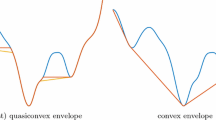Abstract
This paper presents a novel approach to continuously and robustly tracking critical (geometrically, perpendicular and/or extremal) distances from a moving plane point \(p \in \mathbb R^2\) to a static parametrized piecewise rational curve γ(s) (\(s \in \mathbb R\)). The approach is a combination of local marching, and the detection and computation of global topological change, both based on the differential properties of a constructed implicit surface. Unlike many techniques, it does not use any global search strategy except at initialization.
Implementing the mathematical idea from singularity community, we encode the critical distance surface as an implicit surface \(\mathcal{I}\) in the augmented parameter space. A point p s = (p,s) is in the augmented parametric space \(\mathbb R^3 = \mathbb R^2 \times \mathbb R\), where p varies over \(\mathbb R^2\). In most situations, when p is perturbed, its corresponding critical distances can be evolved without structural change by marching along a sectional curve on \(\mathcal{I}\). However, occasionally, when the perturbation crosses the evolute of γ, there is a transition event at which a pair of p’s current critical distances is annihilated, or a new pair is created and added to the set of p’s critical distances. To safely eliminate any global search for critical distances, we develop robust and efficient algorithm to perform the detection and computation of transition events.
Additional transition events caused by various curve discontinuities are also investigated. Our implementation assumes a B-spline representation for the curve and has interactive speed even on a lower end laptop computer.
This work is supported in part by NSF CCR-0310705 and NSF IIS0218809. All opinions, findings, conclusions or recommendations expressed in this document are those of the authors and do not necessarily reflect the views of the sponsoring agencies.
Preview
Unable to display preview. Download preview PDF.
Similar content being viewed by others
References
Arnold, V.: Catastrophe Theory, 3rd edn. Springer, Heidelberg (1992)
Blum, H.: A transformation for extracting new descriptors of shape. In: Models for the perception of speech and visual forms, pp. 362–380. MIT Press, Cambridge (1967)
Chen, X.: Dynamic Geometric Computation by Singularity Detection and Shape Analysis, Ph.D. Thesis Manuscript (2006)
Chen, X., Riesenfeld, R., Cohen, E.: Degree Reduction Strategies for NURBS Symbolic Computation. In: SMI 2006 (to appear, 2006)
Chen, X., Riesenfeld, R., Cohen, E.: Extended Curve Evolute as the Transition Set of Distance Functions (under submission, 2006)
Chou, J.J.: Voronoi diagrams for planar shapes. IEEE Computer Graphics and Applications 15(2), 52–59 (1995)
Elber, G.: Free Form Surface Analysis using a Hybrid of Symbolic and Numeric Computation, Ph.D. thesis, University of Utah, Computer Science Department (1992)
Elber, G., Kim, M.-S.: Geometric constraint solver using multivariate rational spline functions. In: Symposium on Solid Modeling and Applications, pp. 1–10 (2001)
Gregory, A., Lin, M.C., Gottschalk, S., Taylor, R.: A Framework for Fast and Accurate Collision Detection for Haptic Interaction. In: IEEE VR 1999 (1999)
Thompson, T.V., Cohen, I.E.: Direct Haptic Rendering Of Complex Trimmed NURBS Models. In: ASME Proc. 8th Annual Symp. on Haptic Interfaces for Virtual Environment and Teleoperator Systems (November 1999)
Johnson, D., Cohen, E.: A framework for efficient minimum distance computations. In: Proc. IEEE Intl. Conf. Robotics and Automation, May 1998, pp. 3678–3684 (1998)
Johnson, D., Cohen, E.: Bound Coherence for Minimum Distance Computations. In: IEEE Proc. International Conference on Robotics and Automation (1999)
Johnson, D.E., Willemsen, P., Cohen, E.: A Haptic System for Virtual Prototyping of Polygonal Models. In: DETC 2004 (2004)
Bruce, J.W., Giblin, P.J.: Curves And Singularities, 2nd edn. Cambridge University Press, Cambridge (1992)
Koenderink, J.J.: Solid Shape. MIT Press, Cambridge (1990)
Koparlar, P., Mudur, S.P.: A new class of algorithms for the processing of parametric curves. Computer-Aided Design 15, 41–45 (1983)
Lane, J.M., Riesenfeld, R.F.: A theorectical development for the computer generation and display of piecewise polynomial surfaces. IEEE Trans. PAMI 2, 35–46 (1980)
Lin, M.C.: Efficient Collision Detection for Animation and Robotics, Ph.D. thesis, University of California, Berkeley (1993)
Lin, M.C., Manocha, D.: Collision and proximity queries. In: Handbook of discrete and computational geometry, pp. 787–807 (2004)
McNeely, W.A., Puterbaugh, K.D., Troy, J.J.: Six Degree-of-Freedom Haptic Rendering Using Voxel Sampling. In: SIGGRAPH 1999, pp. 401–408 (1999)
Nelson, D.D., Johnson, D., Cohen, E.: Haptic Rendering of Surface-to-Surface Sculpted Model Interaction. In: ASME Proc. 8th Annual Symp. on Haptic Interfaces for Virtual Environment and Teleoperator Systems (November 1999)
Porteous, I.R.: Geometric Differentiation: For the Intelligence of Curves and Surfaces, 2nd edn. Cambridge University Press, Cambridge (2001)
Saunders, P.T.: An Introduction to Catastrophe Theory, 2nd edn. Cambridge University Press, Cambridge (1980)
Sederberg, T.W., Nishita, T.: Curve intersection using Bézier clipping. Computer-Aided Design 22, 538–549 (1990)
Sederberg, T.W., Parry, S.R.: A comparison of curve-curve intersection algorithms. Computer-Aided Design 18, 58–63 (1986)
Sherbrooke, E.C., Patrikalakis, N.M.: Computation of the solutions of nonlinear polynomial systems. Computer Aided Geometric Design 10(5), 379–405 (1993)
Shirley, P., Morley, R.K.: Realistic Ray Tracing, 2nd edn. A K Peters Ltd. (2003)
Author information
Authors and Affiliations
Editor information
Editors and Affiliations
Rights and permissions
Copyright information
© 2006 Springer-Verlag Berlin Heidelberg
About this paper
Cite this paper
Chen, X., Cohen, E., Riesenfeld, R.F. (2006). Tracking Point-Curve Critical Distances. In: Kim, MS., Shimada, K. (eds) Geometric Modeling and Processing - GMP 2006. GMP 2006. Lecture Notes in Computer Science, vol 4077. Springer, Berlin, Heidelberg. https://doi.org/10.1007/11802914_7
Download citation
DOI: https://doi.org/10.1007/11802914_7
Publisher Name: Springer, Berlin, Heidelberg
Print ISBN: 978-3-540-36711-6
Online ISBN: 978-3-540-36865-6
eBook Packages: Computer ScienceComputer Science (R0)




